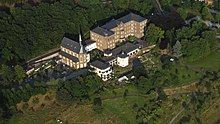Marienhaus Monastery
Marienhaus Monastery is the motherhouse of the Waldbreitbach Order of the Franciscan Sisters of the Blessed Virgin Mary of the Angels . This order was founded in 1863 by M. Rosa Flesch , a simple, socially committed local woman (1826–1906). The monastery is located on a hill east of the Wied across from the main town of Hausen and west of the Waldbreitbach district of Glockscheid.
history
Since 1759 there is evidence of a way of the cross on the Kapellenberg , which Margaretha Rosa Flesch, who lived with a few companions as a hermit in the cross chapel between Waldbreitbach and Hausen in the middle of the 19th century , often used it. Already in the years before the foundation of the order (1863) she took care of the poor and sick on site as a volunteer helper and herbalist. In 1857 she bought a field on the Kapellenberg and in 1861 began the preparations for the construction of a house and a nursing station. On November 11th of the same year the first Marienhaus was ready for occupancy.
After the founding of the order, the field of activity of Margarethe Rosa Flesch, who from 1869 as Mother Rosa headed the community as Superior General , grew rapidly, the first extensions were made, and until 1878, when they were suspended for a 3-year electoral period according to the order's statutes had to, there were already 21 branches with over 100 nuns. Internal differences meant that Mother Rosa was not re-elected as Superior General after 1881; from then on she lived as a simple religious sister in the Marienhaus until her death. Under her successor, Superior General Agatha Simons, the complex on the Kapellenberg was essentially given its current appearance:
- 1886–1887 the motherhouse church was built in neo-Gothic style by the Düsseldorf architect Caspar Clemens Pickel . In the same year the first parent house, which had become too small, was demolished and replaced by a four-story new building (ready for occupancy in 1888). In 1901 this complex received another extension; Even today it constitutes the living area of the Franciscan Sisters and accommodations for conference guests.
- 1891 was the neighboring Antoniushaus as a psychiatric hospital (in the sales contract of the site from October 5, 1888 insane asylum called) was completed with its own chapel. In 1983 the clinic moved into a new building on the periphery of the monastery grounds, while the original hospital wing is now used as an academy.
- In 2003 the Franciscan Sisters redesigned the outside area of the monastery into a publicly accessible creation path with biotopes, orchards, herb and Bible gardens . The visitor area also includes a café-restaurant with a panoramic terrace, a monastery and a bookshop.
Facilities
The social institutions of the Waldbreitbach Franciscan Sisters were subordinate to the Marienhaus GmbH founded for this purpose since 1903 . At the end of 2011, the sisters transferred their facilities to the Marienhaus Foundation they founded. In the 21st century, the Marienhaus Group maintains around 80 hospitals, old people's homes, children's homes, hospices and educational establishments in the federal states of North Rhine-Westphalia , Rhineland-Palatinate , Hesse and Saarland with over 13,800 employees. Only 2 of them are at the founding site on the Waldbreitbacher Kapellenberg:
- The Marienhaus Klinikum St. Antonius Waldbreitbach, the psychiatric hospital founded in 1891 (new building from 1983)
- The Rosa Flesch conference center (including the former Antonius Chapel as a forum and concert hall) organizes retreats, meditation courses, breathing exercises and discussion groups on social and theological topics.
Path of creation
In 2003, some Waldbreitbach Franciscan nuns designed a circular path around the monastery, which includes the historically grown orchards (with a single, over 100 year old pear tree) as well as newly created wetlands, plant and herb gardens. The overall concept combines theological aspects (respect for God's creation) with a spiritual claim (calm, meditation) as well as an effort to ensure the solid quality of the herbs using organic farming methods.
In doing so, the initiators refer to the dual role model function of the order's ancestor Franziskus von Assisi , who worked close to nature as a traveling preacher , and the local order's founder Margaretha Rosa Flesch, who already knew about medicinal herbs as a teenager, collected them and later grew them herself in order to use them medicinally To use care and nursing.
There is a herb garden with over 400 medicinal herbs native to Central Europe and a Bible garden with plants that are mentioned in the Old and New Testaments. Although the harsh Westerwald climate, according to its own statement (information board), limits the cultivation of Mediterranean plants , some cultivars - for example a small olive tree - have succeeded. The vine in the middle is intended as a Christ symbol (reference to Luke 22, 18–20).
Until the turn of the millennium, the monastery’s own honey, apple juice and pear jam were sold. Production has been stopped for reasons of profitability. Instead there are courses in herb cultivation, herb hikes and activities in a creative workshop (interior design with natural products).
The SWR reported in its program Im Grünen Rheinland-Pfalz on March 22, 2005 about this system.
Tourist involvement
The premium hiking trail Klosterweg, hiking for the soul of 17 km connects the Rheinsteig in Rengsdorf with the Westerwaldsteig in Waldbreitbach.
literature
- Hans-Joachim Kracht: Rosa Flesch. Passion for people. Margaretha Rosa Flesch - Life and Work . Paulinus-Verlag, Trier 2005
- Women's Views 2006. A Reading Calendar on Biodiversity . Published by the Federal Environment Minister 2006 (March = Marienhaus Abbey Herb Garden)
Web links
Individual evidence
Coordinates: 50 ° 32 '39.9 " N , 7 ° 25' 3.3" E



